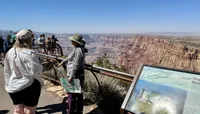

Grand Canyon Area, Arizona
Over the past two billion years, the Grand Canyon has been shaped into what it is today thanks to the Colorado River and erosion. It is 277 miles long, about eighteen miles wide, and over a mile deep; it is literally a giant hole in the ground. Most of the landmark lies within Grand Canyon National Park, which is only in Arizona, but there are also parts located within the Kaibab National Forest, the Hualapai Indian Reservation, the Navajo Nation, the Havasupai Indian Reservation, and the Grand Canyon-Parashant National Monument. The Colorado River runs through and touches seven states. Here, there are thousands of species of plants and animals that can be found. It also contains some of the oldest exposed rock on Earth.
The landmark is divided into the South and North Rim. The South Rim is the most popular, bringing it about ninety percent of the tourists due to the fact that it is easily accessible from major cities like Flagstaff, Williams, and Las Vegas. North Rim is located very close to Utah but it is not quite as accessible. Ten miles separate the two rims as the crow flies but to access it, you must hike over twenty miles through difficult rails or drive over 200 miles via the dangerous, winding roads. The North Rim is often closed in the winter months due to the treacherous conditions.
A Brief History
Theodore Roosevelt successfully established the Grand Canyon National Monument in 1908, though its history dates back millions of years.
It is thought that 'prehistoric' humans settled in and around the area during the last Ice Age. Archaeologists have found artifacts and ruins that date back to around 12,000 years ago! During this time, mammoths still roamed the Earth. After these people, ancestral Pueblo people, Paiute, Navajo, Zuni, and Hopi tribes all inhabited the land during different times and at different places. Today, the Havasupai people claim the area as their original home and claim to have lived here for over 800 years.
In the 1540s, Spanish explorers were the first European explorers to reach the canyon. Over three hundred years later, U.S. explorers began mapping out and spending more time. In the 1880s, the first pioneers began to settle around the rim of the gorge in search of riches. It didn't take long for them to realize that tourism was the way to profit from the landmark. It was granted federal protection in 1893 as a forest reserve. After 1901, tourism really began to boom and in 1903, Teddy Roosevelt made it a National Monument. It became a National Park in 1919.
The Park Today
This park is one of the most visited destinations in the world. Aside from sightseeing, people enjoy hiking, rafting, helicopter tours, Jeep tours, camping, and so much more. The floor of the valley is only accessible by mule, foot, or a boat from upriver. Of course, if you are less adventurous, there are plenty of ways to enjoy the wonders of the area without taking a multiday hike to the bottom. There are plenty of bus and Jeep tours that will take you along the rim and many helicopter and plane tours as well that give you a bird's eye view of the beautiful red rocks. There's a reason why this is one of the most popular landmarks in the world; don't miss out on the chance to take a trip and see why.


The Grand Hotel

Holiday Inn Express Hotel & S...

Best Western Plus Inn of Will...



